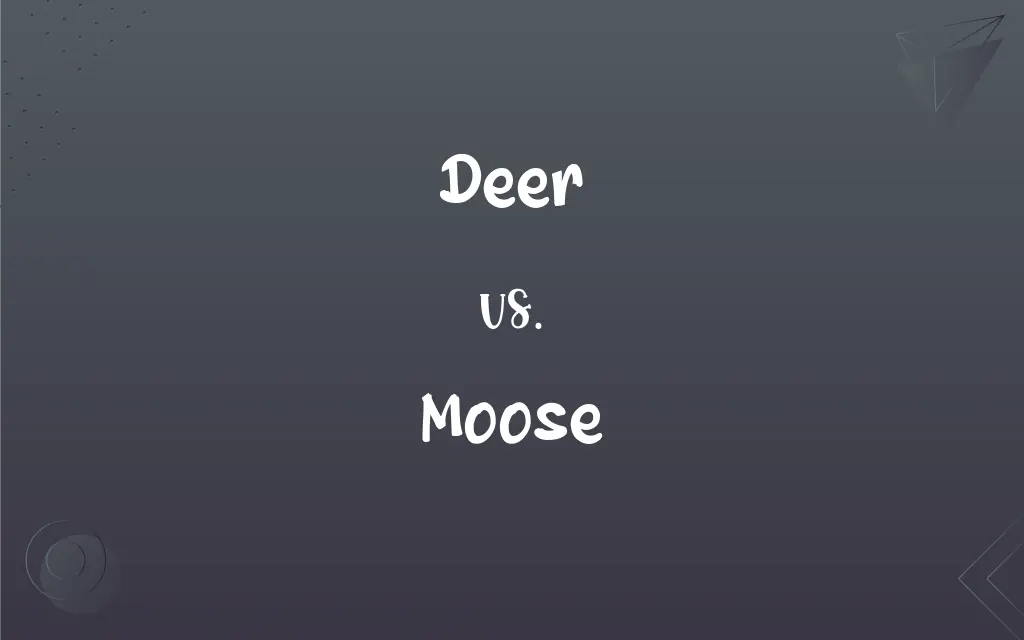Deer vs. Moose: What's the Difference?
Edited by Aimie Carlson || By Harlon Moss || Published on February 26, 2024
Deer are generally smaller, slender, and have branched antlers, while moose are the largest in the deer family, with massive antlers and a bulkier build.

Key Differences
Deer are a diverse group of animals with varying sizes, but generally, they are smaller and more delicately built. Moose, on the other hand, are the largest species in the deer family, characterized by their massive bodies and impressive stature.
Most male deer species have branched antlers that they shed annually. Moose, a member of the deer family, have distinctively large, palmate (flat and open) antlers, which also shed yearly but are much larger and broader.
Deer are adaptable and can be found in various habitats, ranging from forests to grasslands. Moose prefer colder climates and are commonly found in the northern regions of North America and Eurasia, often in forested areas with access to water bodies.
Deer species tend to be more social, often seen in groups. Moose are more solitary, except during mating season or when a cow is with her calves.
Both deer and moose are herbivores, but their diets differ slightly. Deer have a more diverse diet, feeding on leaves, grass, and shrubs. Moose have a preference for aquatic vegetation and will often wade into water bodies to feed.
ADVERTISEMENT
Comparison Chart
Size
Generally smaller, more slender.
Largest in deer family, more bulky.
Antler Type
Branched antlers.
Palmate, larger antlers.
Preferred Habitat
Forests, grasslands.
Colder, forested regions near water.
Social Behavior
More social, often in groups.
Solitary, except in mating season.
Dietary Preference
Leaves, grass, shrubs.
Aquatic vegetation.
ADVERTISEMENT
Deer and Moose Definitions
Deer
A hoofed grazing or browsing animal, with branched bony antlers.
The deer grazed quietly in the meadow.
Moose
The largest species in the deer family, known for its massive size.
A moose was spotted near the lake, impressing onlookers with its size.
Deer
A wild or domesticated ruminant with antlers.
Hunters often seek deer during the autumn season.
Moose
An animal with distinctive broad, palmate antlers.
The moose's antlers spread wide, casting a shadow on the ground.
Deer
An animal known for its agility and adaptable nature in different habitats.
The deer quickly adapted to the changes in its environment.
Moose
A solitary animal, known for its preference for forested, aquatic environments.
The moose spent most of its time alone, foraging near the river.
Deer
A member of the Cervidae family, characterized by elegant and swift movements.
A deer darted across the road, disappearing into the forest.
Moose
A symbol of strength and endurance in various cultures.
In local folklore, the moose represents resilience against adversity.
Deer
A symbol of gentleness and grace in various cultures.
In the painting, the deer stood as a symbol of peace.
Moose
A creature adapted to cold climates, often found in northern regions.
Moose are commonly seen in the snowy landscapes of Canada.
Deer
Any of various hoofed ruminant mammals of the family Cervidae, characteristically having deciduous antlers borne chiefly by the males. The deer family includes the white-tailed deer, elk, moose, and caribou.
Moose
A large deer (Alces alces) of northern North American and Eurasian forests, having a broad pendulous muzzle, humped shoulders, and large, palmate antlers in the male.
Deer
A ruminant mammal with antlers and hooves of the family Cervidae, or one of several similar animals from related families of the order Artiodactyla.
Deer
(in particular) One of the smaller animals of this family, distinguished from a moose or elk
I wrecked my car after a deer ran across the road.
Deer
The meat of such an animal; venison.
Oh, I've never had deer before.
Deer
Any animal, especially a quadrupedal mammal as opposed to a bird, fish, etc.
Deer
Any animal; especially, a wild animal.
Mice and rats, and such small deer.
The camel, that great deer.
Deer
A ruminant of the genus Cervus, of many species, and of related genera of the family Cervidæ. The males, and in some species the females, have solid antlers, often much branched, which are shed annually. Their flesh, for which they are hunted, is called venison.
Deer
Distinguished from Bovidae by the male's having solid deciduous antlers
FAQs
What are the key characteristics of a moose?
Moose are distinguished by their large size, broad antlers, and solitary nature.
What is the habitat of a moose?
Moose prefer colder, forested areas near water bodies.
What are deer?
Deer are hoofed, ruminant mammals known for their branched antlers.
Do all deer have antlers?
Most male deer have antlers, but females typically do not, except in some species like the reindeer.
Can deer adapt to different environments?
Yes, deer are highly adaptable and can live in various habitats.
Are moose aggressive?
Moose can be aggressive, especially during mating season or when they feel threatened.
Are moose social animals?
No, moose are generally solitary except during mating season or when mothers are with calves.
What is the size difference between deer and moose?
Moose are significantly larger and bulkier than most deer species.
Can deer swim?
Yes, many deer species are capable swimmers.
Do deer live in groups?
Many deer species are social and live in groups, known as herds.
How long do deer live?
The lifespan of deer varies by species, but many live between 10-15 years.
How fast can a moose run?
Moose can run up to 35 mph (56 km/h) for short distances.
Do deer have predators?
Yes, deer have several predators, including wolves, bears, and humans.
Are deer native to all continents?
Deer are native to all continents except Australia and Antarctica.
What do deer eat?
Deer are herbivores and mainly eat leaves, grass, and shrubs.
Are moose good swimmers?
Yes, moose are excellent swimmers and often wade into water to feed.
How do moose communicate?
Moose communicate through vocalizations, body language, and scent marking.
What is the gestation period of a moose?
The gestation period for a moose is about 230-240 days.
What is the conservation status of moose?
Moose are generally not endangered, but some populations face threats due to habitat loss and other factors.
What time of year do deer shed their antlers?
Deer typically shed their antlers annually, usually in late winter to early spring.
About Author
Written by
Harlon MossHarlon is a seasoned quality moderator and accomplished content writer for Difference Wiki. An alumnus of the prestigious University of California, he earned his degree in Computer Science. Leveraging his academic background, Harlon brings a meticulous and informed perspective to his work, ensuring content accuracy and excellence.
Edited by
Aimie CarlsonAimie Carlson, holding a master's degree in English literature, is a fervent English language enthusiast. She lends her writing talents to Difference Wiki, a prominent website that specializes in comparisons, offering readers insightful analyses that both captivate and inform.































































